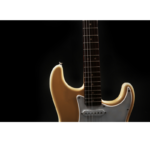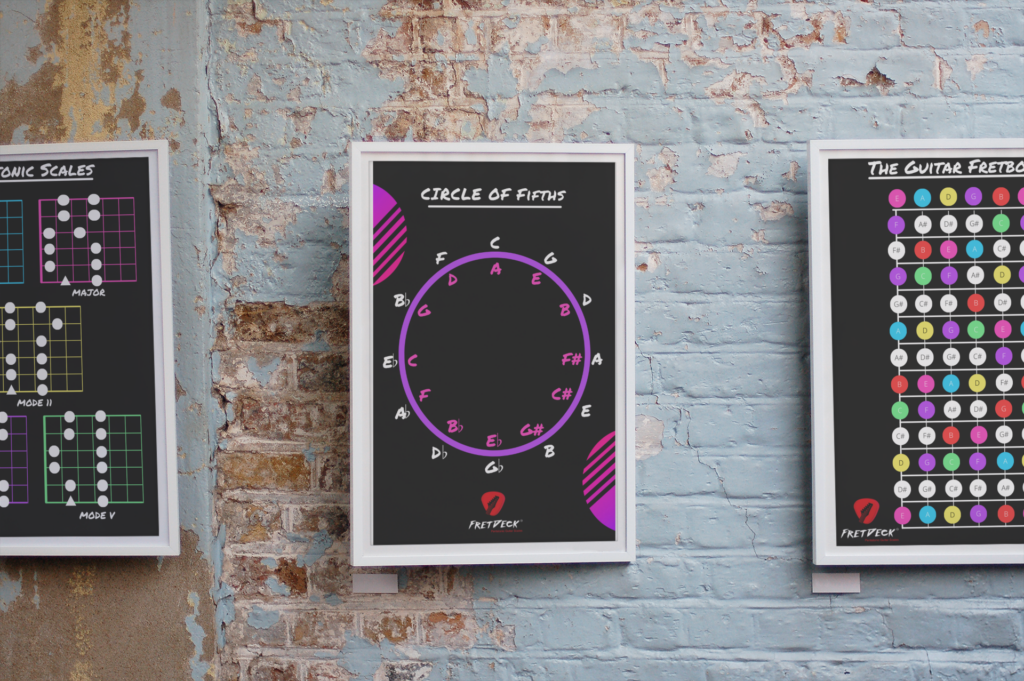When you first learn pentatonic scales, something magical happens. The guitar neck stops looking like a maze and starts feeling like a conversation. You’re not memorizing notes anymore — you’re learning how to speak music.
And at the end, I’ll show you how to keep growing your guitar vocabulary inside my Patreon community, where you’ll get access to FretDeck, SoloCraft, RhythmCraft, and a growing library of practice prompts and lessons every Friday.
Why Every Guitarist Should Learn Pentatonic Scales
The five-note pentatonic scale is the universal musical language — blues, rock, jazz, funk, folk — they all lean on it. When you learn pentatonic scales, you’re not learning something small; you’re unlocking a system that every great guitarist has used.
Here’s why it matters:
- It simplifies the fretboard. With only five notes per octave, the pentatonic scale lets you see patterns instead of chaos. You can move shapes up and down the neck with ease.
- It trains your ear to recognize melody. The gaps between notes give you space to hear phrases — not just patterns.
- It builds confidence for improvisation. Since there are fewer “wrong” notes, you can focus on timing, tone, and feel.
- It’s the foundation for blues and rock solos. Clapton, Hendrix, B.B. King — they all lived inside these five notes.
If you’re serious about developing phrasing, tone, and fretboard freedom, the best place to start is to learn pentatonic scales the way pros internalize them — slowly, musically, and intentionally.

🎸 Join the Guitar Freaks Patreon!
Get SoloCraft™ E-Book & FretDeck™ FREE!
Join Guitar Freaks on Patreon and instantly unlock my full e-book SoloCraft & FretDeck™ Guitar Scales—your step-by-step guide to fretboard mastery and crafting soulful solos.
New video lesson drops every Friday so you’ve always got a fresh, focused practice plan for the week.
👉 Don’t miss out—join now and grab your free copy!
Step 1: Sing Before You Play
Before your fingers even touch the strings, try to sing the notes of the pentatonic scale. Pick one key — say, A minor pentatonic (A, C, D, E, G). Hum each note. Feel the interval jumps. Hear how they fit together.
Why? Because when you learn pentatonic scales with your ear first, your solos sound melodic instead of mechanical.
Once you can sing those five notes confidently:
- Play them on one string.
- Slide between them instead of picking every note.
- Close your eyes and visualize the sound of each note before you play it.
This builds the internal compass — a way to trust your ear before your fingers.
Step 2: Map the Pentatonic Boxes
Now it’s time to visualize the guitar neck. Most players begin with the first “box” pattern. For A minor pentatonic, that’s:
e|-----------------------5--8-
B|-------------------5--8-----
G|---------------5--7---------
D|-----------5--7-------------
A|-------5--7-----------------
E|---5--8---------------------
Play this slowly, ascending and descending. Notice how the shape feels under your fingers. But don’t stop there. The trick to really learn pentatonic scales is connecting all five box patterns across the fretboard.
As you shift up the neck, you’ll see that each shape overlaps slightly with the next. Practice linking them using slides, hammer-ons, and bends — that’s how your playing starts to flow instead of sounding boxed in.
The goal isn’t to memorize five disconnected shapes. It’s to see one connected landscape.
Step 3: Build Motifs, Not Exercises
Once you can visualize the scale, it’s time to make it music.
Choose just two or three notes — maybe C, D, E — and improvise short motifs. Change the rhythm, the phrasing, or the slide into each note.
Try this:
- Play one motif for 10 seconds, then answer it with another phrase.
- Record yourself.
- Listen for melodies that feel natural and repeat them.
When you learn pentatonic scales as tools for melody instead of drills, you build phrasing instincts. That’s how players like Robben Ford or Adam Levy craft solos that breathe — not just run scales.
Step 4: Add Space and Silence
The beauty of the pentatonic scale lies in what isn’t there. With fewer notes, there’s more room for silence — and silence is what gives shape to phrasing.
Practice pausing between phrases. Let a note ring. Use vibrato. Then answer your own line.
Learning pentatonic scales isn’t just about adding notes to your vocabulary; it’s about removing clutter from your playing.
Step 5: Practice Plan to Learn Pentatonic Scales in 8 Weeks
Here’s a practical roadmap to take you from beginner to fluent:
| Week | Focus | What to Practice |
|---|---|---|
| 1 | Ear Training | Sing and play the pentatonic on one string. |
| 2 | Box 1 Mastery | Play the first box in multiple keys. |
| 3 | Box Connections | Link Box 1 and Box 2 using slides. |
| 4 | Motif Creation | Compose two short pentatonic licks. |
| 5 | Phrasing | Use bends, slides, and rhythmic variation. |
| 6 | Cross-Neck Movement | Shift seamlessly between three boxes. |
| 7 | Expressive Control | Add dynamics and vibrato to each phrase. |
| 8 | Recording | Record a 30-second solo using only the pentatonic scale. |
If you follow this schedule, you’ll not only learn pentatonic scales, you’ll own them.
Step 6: Expand the Palette — Mixing Major and Minor Pentatonics
Once you’re comfortable, experiment by mixing the major and minor pentatonic scales. This is where blues magic happens.
For example:
- A minor pentatonic: A, C, D, E, G
- A major pentatonic: A, B, C♯, E, F♯
When you slide between these two sounds, your solos become more expressive. Try playing an A minor pentatonic lick, then shift it three frets down to hit the A major shape. That’s how players like B.B. King and Eric Clapton inject emotion into every phrase.
To truly learn pentatonic scales, you must also learn when to bend the rules. Don’t treat them as cages — treat them as colors on your palette.
Step 7: Use Jam Tracks and Loops
Scales only come alive when you play them over music. Find a backing track in A minor or E minor and improvise.
- Play along for five minutes a day.
- Focus on melody, not speed.
- End every practice session with a simple two-note bend or motif.
You’ll notice how each week your phrasing improves — not because you learned more notes, but because you listened more carefully.
You can find great free jam tracks right here on my site at Guitar Freaks Blog — especially the ones that line up with my FretDeck lessons.
Join the Guitar Freaks Patreon Community
If you’ve made it this far, you’re already serious about wanting to learn pentatonic scales and use them musically. But here’s the truth — it’s hard to keep momentum on your own.
That’s why I built the Guitar Freaks Patreon. Inside, you’ll get:
🎸 FretDeck Download — my visual learning system that helps you master pentatonic scales in every key.
📘 SoloCraft E-book — a creative guide to building guitar solos step by step.
🪘 52 Practice Prompts — weekly inspiration to keep your playing fresh.
🎧 Friday Video Lessons — a new jam or challenge every week.
💬 Private Discord Access — share your progress and get feedback from other players.
You want to learn pentatonic scales and finally understand the fretboard.
I built the tools I wish I’d had — visual systems, weekly challenges, and a community to hold me accountable.
Join my Patreon today and get everything — FretDeck, SoloCraft, RhythmCraft, and 52 Guitar Challenges — all included.
👉 Join Guitar Freaks Patreon Here
Don’t wait until “someday.” You can learn pentatonic scales faster when you have a mentor and a system.

🎸 Join the Guitar Freaks Patreon!
Get SoloCraft™ E-Book & FretDeck™ FREE!
Join Guitar Freaks on Patreon and instantly unlock my full e-book SoloCraft & FretDeck™ Guitar Scales—your step-by-step guide to fretboard mastery and crafting soulful solos.
New video lesson drops every Friday so you’ve always got a fresh, focused practice plan for the week.
👉 Don’t miss out—join now and grab your free copy!
Final Thoughts: Simplicity Is Your Superpower
When you learn pentatonic scales, you learn simplicity. You learn to let melody breathe. You learn to make every note count.
So instead of chasing complicated theory, spend a week just exploring those five notes. Play them slowly. Bend them. Sing them. Live inside them.
Because when you internalize the pentatonic scale, you’re not just learning guitar — you’re learning the language of music.
Keep Learning
If you enjoyed this article, check out these related guides on Guitar Freaks Blog:
And for an external deep-dive into the theory behind pentatonics, visit Berklee Online’s Guitar Improvisation Course — an excellent complement to your journey.










